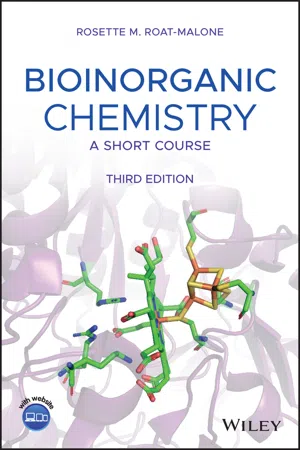
- English
- ePUB (mobile friendly)
- Available on iOS & Android
About this book
Introduces students to the basics of bioinorganic chemistry
This book provides the fundamentals for inorganic chemistry and biochemistry relevant to understanding bioinorganic topics. It provides essential background material, followed by detailed information on selected topics, to give readers the background, tools, and skills they need to research and study bioinorganic topics of interest to them. To reflect current practices and needs, instrumental methods and techniques are referred to and mixed in throughout the book.
Bioinorganic Chemistry: A Short Course, Third Edition begins with a chapter on Inorganic Chemistry and Biochemistry Essentials. It then continues with chapters on: Computer Hardware, Software, and Computational Chemistry Methods; Important Metal Centers in Proteins; Myoglobins, Hemoglobins, Superoxide Dismutases, Nitrogenases, Hydrogenases, Carbonic Anhydrases, and Nitrogen Cycle Enzymes. The book concludes with chapters on Nanobioinorganic Chemistry and Metals in Medicine. Readers are also offered end-of-section summaries, conclusions, and thought problems.
- Reduces size of the text from previous edition to match the first, keeping it appropriate for a one-semester course
- Offers primers and background materials to help students feel comfortable with research-level bioinorganic chemistry
- Emphasizes select and diverse topics using extensive references from current scientific literature, with more emphasis on molecular biology in the biochemistry section, leading to a discussion of CRISPR technology
- Adds new chapters on hydrogenases, carbonic anhydrases, and nitrogen cycle enzymes, along with a separate chapter on nanobioinorganic chemistry
- Features expanded coverage of computer hardware and software, metalloenzymes, and metals in medicines
- Supplemented with a companion website for students and instructors featuring Powerpoint and JPEG figures and tables, arranged by chapter
Appropriate for one-semester bioinorganic chemistry courses, Bioinorganic Chemistry: A Short Course, Third Edition is ideal for upper-level undergraduate and beginning graduate students. It is also a valuable reference for practitioners and researchers in need of a general introduction to the subject, as well as chemists requiring an accessible reference.
Frequently asked questions
- Essential is ideal for learners and professionals who enjoy exploring a wide range of subjects. Access the Essential Library with 800,000+ trusted titles and best-sellers across business, personal growth, and the humanities. Includes unlimited reading time and Standard Read Aloud voice.
- Complete: Perfect for advanced learners and researchers needing full, unrestricted access. Unlock 1.4M+ books across hundreds of subjects, including academic and specialized titles. The Complete Plan also includes advanced features like Premium Read Aloud and Research Assistant.
Please note we cannot support devices running on iOS 13 and Android 7 or earlier. Learn more about using the app.
Information
1
INORGANIC CHEMISTRY AND BIOCHEMISTRY ESSENTIALS
1.1 INTRODUCTION
1.2 ESSENTIAL CHEMICAL ELEMENTS
Table of contents
- COVER
- TABLE OF CONTENTS
- PREFACE
- ACKNOWLEDGMENTS
- BIOGRAPHY
- ABOUT THE COMPANION PAGE
- 1 INORGANIC CHEMISTRY AND BIOCHEMISTRY ESSENTIALS
- 2 COMPUTER HARDWARE, SOFTWARE, AND COMPUTATIONAL CHEMISTRY METHODS
- 3 IMPORTANT METAL CENTERS IN PROTEINS
- 4 HYDROGENASES, CARBONIC ANHYDRASES, NITROGEN CYCLE ENZYMES
- 5 NANOBIOINORGANIC CHEMISTRY
- 6 METALS IN MEDICINE, DISEASE STATES, DRUG DEVELOPMENT
- INDEX
- END USER LICENSE AGREEMENT